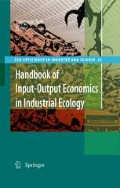The International Organization for Standardization (ISO) recommends the use of life-cycle assessment (LCA) to better comprehend and reduce environmental impacts related to manufactured products and services offered to our society. The principles of LCA are presented in the international standard ISO 14040; however, the implementation of the standard is not simple, and a couple of studies have addressed the existing limitations (Khan et al. 2002; Ross and Evans 2002).
One fundamental question is how to characterize a given environmental insult and how to select an appropriate metric to evaluate and minimize their impacts. This problem stem from the multiplicity of environmental insults caused by human activities, which are difficult to compare using a single approach. Moreover, most environmental problems have an intrinsic temporal dimension since environmental impacts persist in the environment for years and in some cases for generations. This yields sustainability concerns, which demand frameworks that allow the comparison of outcomes over time.
Access this chapter
Tax calculation will be finalised at checkout
Purchases are for personal use only
Preview
Unable to display preview. Download preview PDF.
References
Enting, I. G., Wigley, T. M. L., & Heimann, M. (1994). Future emissions and concentrations of carbon dioxide: Key ocean/atmosphere/land analyses (CSIRO Division of Atmospheric Research Technical Paper No. 31). Aspendale: Commonwealth Scientific and Industrial Research Organisation.
Gagnon, L., Bélanger, C., & Uchiyama, Y. (2002). Life-cycle assessment of electricity generation options: The status of research in Year 2001. Energy Policy, 30(14), 1267–1278.
Hertwich, E. G., Hammitt, J. K., & Pease, W. S. (2000). A theoretical foundation for life-cycle assessment: Recognizing the role of values in environmental decision making. Journal of Industrial Ecology, 4(1), 13–28.
Houghton, J. T., Ding, Y., Griggs, D. J., Noguer, M., van der Linden, P. J., Dai, X., Maskell, K., & Johnson, C. A. (2001). Climate change 2001: The scientific basis. New York: Cambridge University Press, 881 p.
Keeling, C. D., & Whorf, T. P. (2003). Atmospheric CO 2 concentrations (ppmv) derived from in situ air samples collected at Mauna Loa Observatory, Hawaii, Carbon Dioxide Research Group Scripps Institution of Oceanography. Retrieved August 7, 2003, from http:// cdiac.esd.ornl.gov/ftp/maunaloa-co2/maunaloa.co2.
Khan, F. I., Raveender, V., & Husain, T. (2002) Effective environmental management through life cycle assessment. Journal of Loss Prevention in the Process Industries, 15, 455–466
Lenzen, M., & Munksgaard, J. (2002). Energy and CO2 life-cycle analyses of wind turbines — review and applications. Renewable Energy, 26, 339–362.
Metz, B., Davidson, O., Martens, J., Van Rooijen, S., & Van Wie Mcgrory, L. (2000). Methodological and technological issues in technology transfer, special report of the intergovernmental panel on climate change. Cambridge: Cambridge University Press, 432 p.
Metz, B., Davidson, O., Swart, R., & Pan, J. (2001). Climate change 2001: Mitigation. New York: Cambridge University Press, 752 p.
Nakicenovic, N., & Swart, R. (2000). Emissions scenarios. Special report of the intergovernmental panel on climate change. Cambridge: Cambridge University Press, 570 p.
Nash, J., & Ehrenfeld, J. (1996). Code green: Business adopts voluntary environmental standards. Environment, 38(1), 16–30
O'Neill, J. (1993). Ecology policy and politics. New York: Routledge, 227p.
Office of Management and Budget (OMB). (2003). OMB Circular No. A-94, Office of Management and Budget, U.S. Presidency. Retrieved February 11, 2003, from http://www.whitehouse. gov/omb/circulars/a094/a94 appx-c.html.
ORNL/RFF (Oak Ridge National Laboratory and Resources for the Future). (1995). External costs and benefits of fuel cycles. Washington, DC: McGraw-Hill, Utility Data Institute, 7 Volumes.
Pacca, S. (2004). Impacts from decommissioning of hydroelectric plants. (submitted to Climatic Change on July 2004).
Pacca, S., & Horvath, A. (2002). Greenhouse gas emissions from building and operating electric power plants in the Upper Colorado River Basin. Environmental Science and Technology, 36(14), 3194–3200.
Penner, J. E., Lister, D. H., GriMgs, D. J., Dokken, D. J., & McFarland, M. (1999). Aviation and the global atmosphere, a special report of IPCC working groups I and III in collaboration with the scientific assessment panel to the Montreal protocol on substances that deplete the ozone layer. Cambridge: Cambridge University Press, 373 p.
Portney, P. R., & Stavins, R. N. (2000). Public policies for environmental protection. Washington, DC: Resources for the Future, 294 p.
Ross, S., & Evans, D. (2002). Use of life cycle assessment in environmental management. Environmental Management, 29(1), 132–142.
Tol, R. S. J. (2003). Is the uncertainty about climate change too large for expected cost-benefit analysis? Climatic Change, 56(3), 265–289.
United Nations Development Program (UNDP). (2004). Human Development Report 2004. Retrieved November 10, 2004, from http://hdr.undp.org/reports/global/2004/.
Watson, R. T. (2000). IPCC special report on land use, land-use change and forestry, intergovernmental panel on climate change. United Nations Environmental Program, World Meteorological Organization, Cambridge: Cambridge University Press, 375 p.
Watson, R. T., Zinyowera, M. C., & Moss, R. H. (1997). The regional impacts of climate change: An assessment of vulnerability, a special report of IPCC working group II. Cambridge: Cambridge University Press, 517 p.
Author information
Authors and Affiliations
Editor information
Editors and Affiliations
Rights and permissions
Copyright information
© 2009 Springer Science+Business Media B.V.
About this chapter
Cite this chapter
Pacca, S. (2009). Life-Cycle Assessment (LCA) as a Management Tool: An Emphasis on Electricity Generation, Global Climate Change, and Sustainability. In: Suh, S. (eds) Handbook of Input-Output Economics in Industrial Ecology. Eco-Efficiency in Industry and Science, vol 23. Springer, Dordrecht. https://doi.org/10.1007/978-1-4020-5737-3_13
Download citation
DOI: https://doi.org/10.1007/978-1-4020-5737-3_13
Publisher Name: Springer, Dordrecht
Print ISBN: 978-1-4020-4083-2
Online ISBN: 978-1-4020-5737-3
eBook Packages: Earth and Environmental ScienceEarth and Environmental Science (R0)

